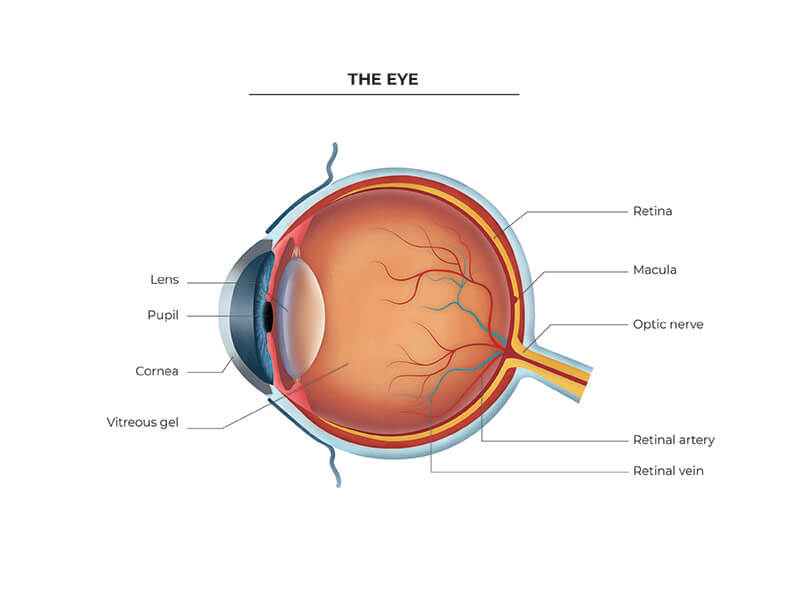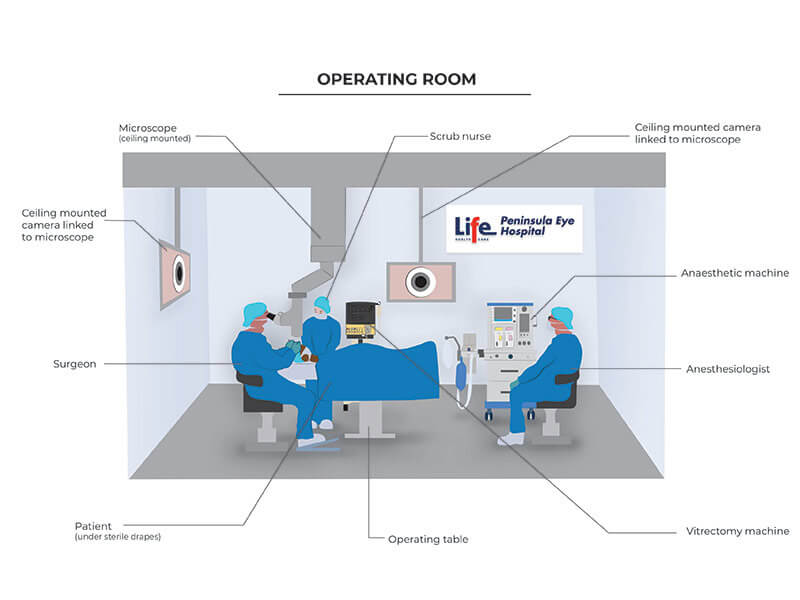Cataract Operation Cape Town
What is a cataract?
A cataract is a clouding of the lens in your eye. The lens consists of proteins which can denature over time. This decreases the amount of light entering the eye and causes blurry vision or a general decrease in the quality of vision.
What causes a cataract?
The most common cause is age. The clear proteins in the lens denature and turn brown throughout our lifetime, and eventually reach a point where they affect our quality of vision. Other causes such as trauma, diabetes, excessive UV exposure, inflammation in the eye (uveitis) or a strong family history may cause a cataract at a younger age.
What treatment is available?
The most effective treatment for cataracts is an operation to remove the cloudy lens, and replace it with an artifical clear lens. This lens will remain in your eye lifelong. Diets or drugs have not been shown to slow or stop the development of cataract.

How does a cataract affect your sight?
Blurry vision
You may notice that your sight has become blurry or misty over a long period of time.
Scattering of light
Certain types of cataract can cause your vision to be worse in direct lighting conditions, such as street lights, direct sunlight and car headlights.
Change of colour vision
Your colour vision may become washed out or faded.
When should I have the cataract operation?
Surgery is only indicated when you feel your eyesight intereferes with your daily life and your ability to read, work or do the things you enjoy. You will be carefully examined to decide if cataract surgery is appropriate for you, and to determine if there are any other conditions that are causing a decrease in your vision.
How is a cataract operation performed?
Cataract operations are mostly done under local anaesthetic with intravenous sedation, administered by an anaesthetist. It is rarely performed under general anaesthetic. We will ensure that you are comfortable and relaxed throughout the procedure. You may vaguely see some movement but no details of the operation.
The operation is done with the aid of a microscope and a ‘phacoemulsification’ machine which controls all fuidics in the eye. A small incision is made in the cornea; the incision is so small that stictches are not usually necessary. During the operation the lens containing the cataract is removed and replaced with an artifical lens. This lens will remain in your eye premanently. A clear shield will be placed over your eye at the end of the procedure to protect it from accidental rubbing and bumping after the operation.

Before the operation
- You will be contacted the day before the operation to confirm your admission time to Peninsula Eye Hospital.
- Do not eat or drink for 6 hours before your admission time.
- Please take your usual medication on the morning of the operation with a small sip of water, with the exception of diabetic medication.
- If the operation is in the morning, do not take any diabetic medication.
- If the operation is in the afternoon, take half your usual dose with breakfast in the morning.
- Bring your diabetic medication with you to the hospital.
- If you are taking blood thinners, it is important to inform me prior to surgery. It is not always necessary to stop blood thinners before a cataract operation.
- Dress in comfortable clothing and do not wear makeup, cosmetics or perfume at the Eye Hospital.
- Ensure you have an authorization number from your medical aid prior to surgery. You will be required to bring this number with on the day of surgery for admission to Peninsula Eye Hospital.
- The surgery takes approximately 20-30 minutes, but you will be at the Eye Hospital for approximately 3-4 hours on the day.
- Please ensure that someone drives your home after the surgery. You will receive sedation and cannot drive on the day of surgery. You will be advised on your post-operative visit when it is safe to resume driving.
Cataract operation after care (post-operative instructions)
- Keep your eye shield on until the your visit the following day.
- Do not rub your eye.
- You can resume your regular diet and all medications after surgery.
- Start the eye drops the day after surgery, after your post-operative visit. Take both drops 4 times per day. You can take them at the same time, waiting approximately 5 minutes between drops. It does not matter which drop you put in first. The drops will last you one month. If they are done sooner, a repeat script has been given to you.
- Light activity such as walking or light reading is fine. Don’t do any strenuous activity or exercise for 2 weeks after the operation. This includes lifting heavy weights, bending all the way over, golfing, jogging, gym or tennis.
- You may read, write and watch TV. Remember that your vision will be quite variable for a few weeks.
- You may take a shower or bath after the first day, but take care not to get water or shampoo in the operated eye.
- You may wear your glasses during the day, and a shield at night for the one week after surgery. A special transpore tape is included in your post-operative care pack. You only need to wear to the shield at night; it is not necessary to place any gauze under the shield.
- You may resume driving after your first post-operative visit if your vision is clear and you feel ready to drive. Do not drive a car while the eye is patched.
- Be careful when holding children or animals due to their unpredictable movements. Walk cautiously, especially while wearing a patch or shield.
- You may have some unusual visual sensations, such as “shimmering” or “streaks”. This is normal for the first week.
- You may have new glasses made 6 weeks after surgery
If you experience any of the following symptoms, please contact the practice immediately (day or night):
- Decreased vision or vision loss. The vision should get better day by day. It should never get worse.
- Pain that persists despite the use of the over-the counter pain medication.
- Nausea, vomiting or excessive coughing.
- Light flashes or significant floaters in your eye.
The above are signs of infection or raised eye pressure. Although extremely rare, if you experience any of these, you need to be seen immediately.
Frequently Asked Questions
Can you exercise after cataract surgery?
Avoid exercise for at least two weeks after cataract surgery. This includes activities such as heavy lifting, where your head moves below your waistline. You may resume normal daily activities such as cooking, light house chores, shopping and gentle strolling from the first day. But delay strenuous activities for a minimum of 2 weeks and talk to your doctor ahead of swimming or resuming contact sport.
What sedation is used for cataract surgery?
Cataract surgery is usually performed under local anaesthetic. An anaesthetist administers intravenous sedation (medication) and monitors you throughout the procedure. Thereby ensuring you remain comfortable, relaxed and without pain. Occasionally general anaesthetic is used; however, this is rare.
How long to fully recover from cataract surgery?
Recovery time from cataract surgery can vary between patients. A week after surgery most people experience minimal visionary distortion and discomfort. By week 6, eyes are usually stabilised enough to have a new pair of glasses made at your optometrist.
How long after cataract surgery can you see clearly?
After cataract surgery it is normal for your vision to be blurry, distorted or unstable for a few days. Clarity of vision usually improves over the first week with minimal discomfort and distortion thereafter. Within 6 weeks your vision should have stabilised.
Can cataracts come back after surgery?
Cataracts cannot grow back after surgery. However, it is possible to develop a cloudiness on the capsule that holds the lens in place. This is sometimes called a “secondary cataract”. This can be cleared with a simple laser procedure in the clinic. Cataracts cannot grow back after surgery. However, it is possible to develop a cloudiness on the capsule that holds the lens in place. This is sometimes called a “secondary cataract”. This can be cleared with a simple laser procedure in the clinic.